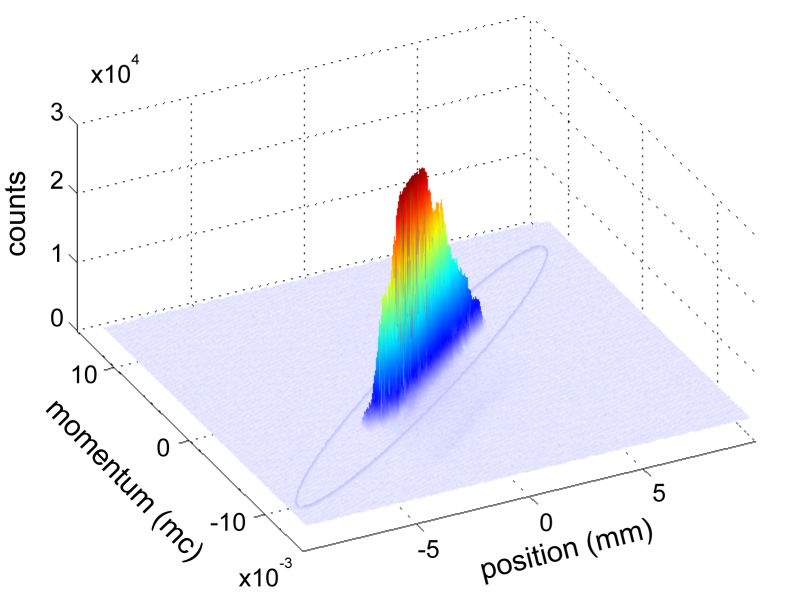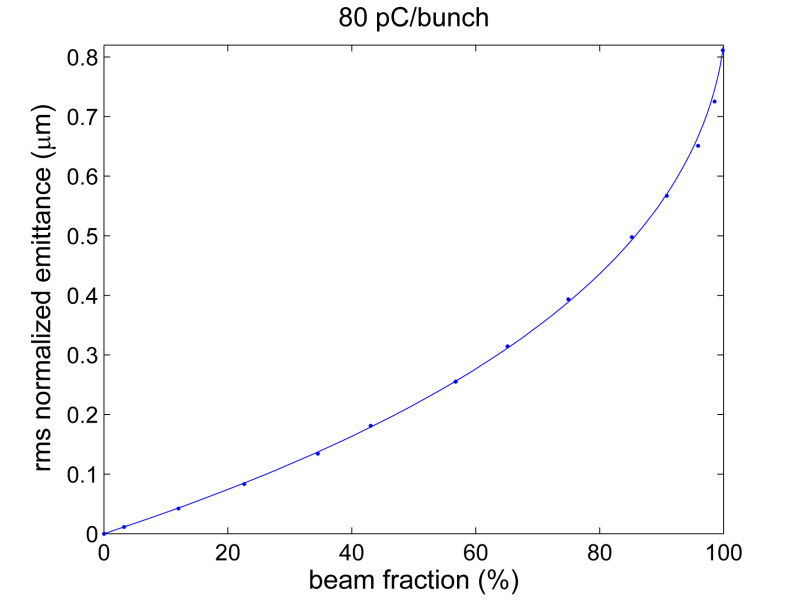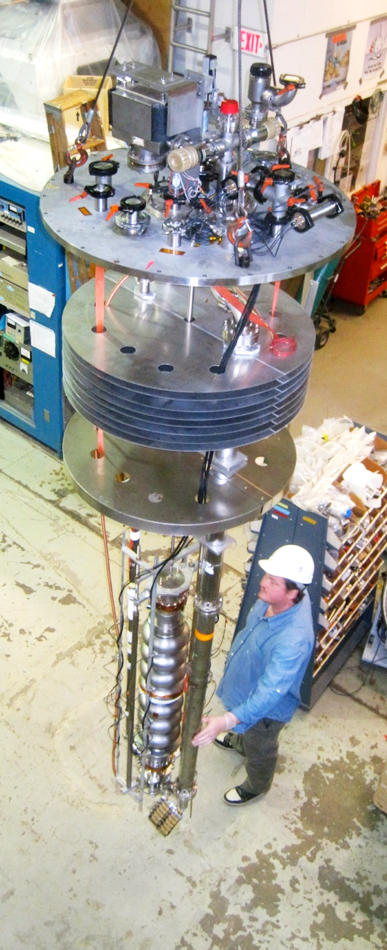X-RAY RUNS: Apply for Beamtime
2017 Nov 1 - Dec 21
2018 Feb 7 - Apr 3
2018 Proposal/BTR deadline: 12/1/17
2018 Apr 11 - Jun 4
2018 Proposal/BTR deadline: 2/1/18
Synchrotron x-ray sources have become essential tools across the sciences, medicine, and engineering. To continue the rapid pace of advances in these fields, researchers need much better high-intensity, short wavelength x-ray sources to capture ultra-fast phenomena and probe materials with atomic resolution. Existing continuous duty synchrotrons fall short because they produce mostly incoherent light. Because of this limitation, there is a world-wide race to build coherent, high-flux hard x-ray sources. The National Science Foundation (NSF) has been supporting R&D at Cornell University to innovate, design and prototype superconducting Energy Recovery Linac (ERL) technology as a basis for a next generation source (see erl.chess.cornell.edu). In October 2011 the Cornell team surpassed two project milestones and is now within striking distance of delivering performance matching theoretical limits towards a coherent source. Their innovations advance the U.S. well ahead of other countries in the race to produce continuous duty, ultra-high brilliance hard x-ray beams and define new horizons for scientific research with coherent light.
Implications for a Hard X-ray Coherent Light Source
An ERL light source exceeds the brilliance of storage ring facilities by creating ultra-low emittance electron bunches, accelerating them in a superconducting linear accelerator, then circulating them only once through a series of small-gap undulators to produce ultra-bright, ultra-short pulses of hard x-ray light. Two of the biggest R&D challenges are to prove it possible to build an electron injector and superconducting linac with the required extraordinary capabilities and quality. As described below, seminal advances and milestones have been achieved in both areas. The delivered brightness of the injector electrons, when accelerated to 5 GeV, would greatly exceed the brightness of all storage rings in operations today.
If the brilliance is high enough, the x-ray beam become mostly transversely coherent. The key requirement for a coherent light source is an electron beam of sufficiently low geometric emittance. The geometric emittance varies with the electron energy, so accelerator physicists often cite normalized emittance, which is energy independent. At high energies, the geometric emittance scales inversely with the ratio of the electron energy to its rest mass energy. Thus, at 5 GeV, the proposed energy of Cornell’s ERL, the geometric emittance is the normalized emittance divided by 10,000.
Cornell’s ERL goal for a coherent ERL source is ~10 pm geometric emittance (0.1 micrometers normalized emittance) at ~20 pC bunch charge in the high coherence mode and ~30 pm (0.3 micrometers normalized emittance) at ~80 pC bunch charge in the high flux mode (See, e.g., Bilderback et al., Synchrotron Radiation News, 6 (2010) 32-41; Bilderback et al., New J. Physics, 12 (2010) 035011). As described below, the respective normalized emittances that were demonstrated with Cornell’s injector were 0.4 micrometers at 20 pC bunch charge and 0.8 micrometers at 80 pC bunch charge. These are within a factor or 4 of what is required. Further advances are expected, as Cornell is only two years into a five year program of improving the injector.
Yet even these extraordinary emittances understate the accomplishment. The emittance of an electron bunch assumes a transverse profile, typically the Gaussian profile seen in storage rings. The ERL injector bunches are not Gaussian and concentrate most of the electrons in the bunch core, and these core electrons contribute most strongly to the coherent radiation. Thus, the coherent fraction of the resultant x-ray beam (and the beam brightness) will be even larger than the low emittances would imply if the numbers were for typical Gaussian profiles.
The way is now clear torwards achieving the world-wide goal of a continuous duty, coherent hard x-ray light source.


Measured transverse phase space of the ERL injector beam at 80pC/bunch charge (top); RMS normalized emittance of the beam vs. the beam fraction (bottom).
Injector. The ERL injector has to produce electrons bunches with unprecedented small emittance. The past year has seen significant gains in many areas of injector development. Most recently the DC photocathode and prototype linac achieved one of the most important project goals, a measured normalized emittance of 0.8 micrometer, the smallest ever recorded from a DC electron gun with bunch charge large enough to produce a full 100 milliAmperes beam. The electron-beam normalized emittance is the product of beam size and transverse momentum spread at the beam's waist divided by the electron mass times the speed of light. With an emittance of 0.8 micrometers, an ERL light source would have average spectral brightness higher than any hard x-ray storage ring facility, either in existence or under construction. The achieved small emittance value proves that, with this injector, an ERL could produce coherent x-ray beams that can be focused down to atomic dimensions to investigate materials with unprecedented precision and speed.
The DC gun creates an electron beam by shining a high-power laser onto a photocathode target and accelerating the ejected photoelectrons to 5 million electron volts, or 99.5% the speed of light. The laser fires about a billion times per second, creating electron bunches of about 80 picocoulombs. At low energy, the electrons tend to repel one another and enlarge the bunch size, thereby compromising the emittance. To minimize this effect, the Cornell prototype injector uses a delicate balance of electric and magnetic fields to ‘freeze’ the compact bunches by accelerating the electrons to nearly the speed of light as quickly as possible.
Unlike storage rings, in an ERL the electron bunches are not in dynamic equilibrium and therefore do not exhibit a Gaussian distribution in size or shape. As such, the core of the electron bunches will contain 50% of the charge and have, the team calculates, an even smaller beam emittance of only 0.3 micrometer. This value is only a factor of 2 larger than the intrinsic emittance of the photocathode - the natural spread of electron velocities coming out of the material itself when the density of electrons is very low and their strong repulsion is not felt.
These latest results are particularly relevant because the achieved 0.8 micrometer emittance is not far from the minimal emittance of 0.5 micrometer predicted by computer models. When the laser shape is further sculpted and the DC electron gun is run at the full design voltage of 500kV, rather than at 350kV installed today, the team expects a minimal emittance of 0.3 micrometer. This value is considered nearly a theoretical limit set by the thermal energy of the electrons leaving the photocathode material – Cs3Sb in this case – no source could be better. And when accelerated to 5 GeV electron energy, the very small bunch of electrons will emit x-rays into a nearly diffraction-limited, forward-directed beam as highly collimated as nature will allow.
Because no one has ever created an ERL light source operating with high-energy particle beams, the Cornell results bolster confidence in the ERL technology approach. The effect of non-Gaussian bunches and their potential to significantly enhance the capabilities of ERL x-ray light sources was not appreciated at the start of the project. The recent results make it clear that the original design goals of the ERL can be pushed even further than originally envisioned. Non-Gaussian bunches could multiply the effective brilliance of an ERL light source, in terms of coherent x-ray delivered to a sample, by another factor of ten, which is a very exciting prospect.
Cornell has spent much time and effort improving each part of the prototype injector, involving successful R&D on the laser and laser transport systems, photocathode development and characterization, control systems for fast feedback, high voltage, and RF, superconducting injector cavities, and mechanical and beam-based alignment and controls. The end result is that accurate emittance measurements can be recorded in a matter of seconds, allowing the team to carry out multi-parameter optimizations. With these efficiencies, the injector now functions like an analog computer that can rapidly test new operational modes and alignment strategies, similar to how digital computer models are used for design and simulations. The prototype injector will continue to be used to advance towards other project milestones, such as higher injector currents and photocathode lifetimes.
Superconducting Linac. After the injector, a superconducting linac has to accelerate bunches to high energy without increasing their very low emittance. This accelerator has to be on continuously, which can only be achieved with superconducting radio-frequency (SRF) accelerating cavities. Recently Cornell successfully produced and tested the first prototype of an ERL main-linac superconducting cavity (see link here).
The first vertical cavity test has already reached performance specifications for the ERL main-linac. This cavity has been completely designed, constructed, and tested by Cornell's SRF group. The cavity shape has been optimized to allow 200mA in the ERL linac, even with realistic construction errors. Starting with bare niobium sheet metal, the SRF team constructed it from scratch, carefully controlling dimensions along the way. This led to a field flatness of 85% without tuning, an exceedingly high number indicating exceptional production accuracy. Chemical cleaning has also been performed in-house.
This first ERL-main-linac cavity has now been tested at operation temperature and operation field levels where it achieved the required quality factor, Q, of about 2x1010. Reaching this high Q is a very significant step for the ERL project, because a high Q limits the power consumption of this large accelerator
While reaching this performance specification with the first prototype in a vertical test is a promising achievement, it will now have to be shown that this quality factor can be maintained in horizontal tests after the cavity has been equipped with its helium vessel, RF couplers and higher order mode absorbers. A horizontal test is already being developed and is planned for 2012.
Because of the connection of high Q to low operation costs, Cornell’s successful prototype cavity is good news not only for x-ray ERLs but also for Project-X at Fermilab, the Next Generation Light Source being contemplated by the Department of Energy, Electron-Ion colliders, spallation-neutron sources, and accelerator-driven nuclear reactors.
Building the ERL Infrastructure
The Cornell project team believes that accelerator developments must advance hand in hand with other developments if an ERL facility is to be achieved. Accordingly, there has also been considerable progress in areas such as undulators, detectors, and x-ray optics. Technical developments cannot occur in isolation, but must be driven by specific science applications. In this regard, Cornell hosted six international science workshops in June, 2011, involving a total enrollment of nearly 500 participants (see XDL2011 and reports forthcoming in Synchrotron Radiation News). Many exciting scientific frontiers were identified that that will be enabled by ERL technology. Finally, the Cornell work has proceeded with a very competent group of graduate students and post-docs. This is important towards fostering the human infrastructure, as well as the technical and scientific infrastructure, that will be needed for an ERL facility to succeed.
This work is supported by NSF awards DMR-0807731 and DMR-0936384 and DOE grant DE-SC000396 for work on photocathodes. A list of the latest research publications from the Cornell team can be found at http://erl.chess.cornell.edu/papers/papers.htm.

Cornell has completed construction of the first 7-cell superconducting RF cavity as a prototype of those needed to power a full-sized Cornell-ERL light source. Andriy Ganshyn, a Research Associate in the SRF group, is shown here with the vertical test apparatus.
Cornell Chronicle Online News:
http://www.news.cornell.edu/stories/Oct11/erlUpdate.html
or (pdf)
Submitted by: Ernie Fontes, CHESS, Cornell University
